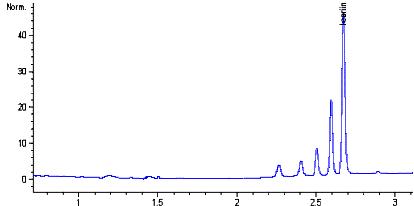Extract Monographs
Epimedium
The Epimedium species have been used extensively in Traditional Chinese Medicine for their warming or “Yang” tonic effect, which shows great therapeutic properties for the kidney, enhances the immune system, and increases sperm production, thereby acting sexual enhancement. Up to date, over 60 species of Epimedium have been reported, but only five of these are recorded in the Chinese Pharmacopeia, namely, Epimedium bravicornum Maxim., E. sagittatum (Sieb. et Zucc) Maxim., E. koreanum Nakai, E. pubescens Maxim. and E. wushanense T.S. Ying [1].
Flavonoids are the main active chemical constituents of Epimedium species, the four major flavonoids contributing to their effects being epimedins A, B, and C, and icariin. These biologically active constituents are flavonol glycosides with an isoprenyl group substituted on carbon 8. However analysis of natural health products currently available on the market containing Epimedium rely mostly on the presence of icariin. CPC established characteristic Rapid Resolution Liquid Chromatography (RRLC) profiles for complex mixtures of flavonoids from Epimedium species. The Zorbax Eclipse XDB column is able to fully separate four major flavonoids, which are epimedins A, B, and C, and icariin, for both quantitative and qualitative analysis in less than 3 minutes [2]. Evidently, our Canphy® Epimedium P.E. is trustworthy with high extraction effectiveness and stable characteristic RRLC profiles. Canphy® Epimedium P.E. is standardized at 10% icariin and 20% icariin
References
[1] The united states pharmacopeial convention. USP 30 Volumn 1. 2007. P 924.
[2] Yuan-chun Ma, Xiao-Qiang Wang, FeiFei Hou, Jie Ma, etc. Simultaneous quantification of polyherbal formulations containing Rhodiola rosea L. and Eleutherococcus senticosus Maxim. using rapid resolution liquid chromatography (RRLC). Journal of Pharmaceutical and Biomedical Analysis (2011)55,908-915.


